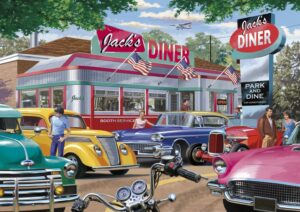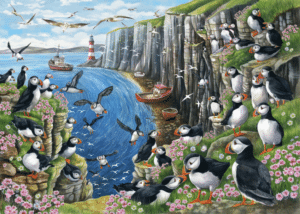How to Create the Perfect Puzzle for the Adult Market
Published on 21/11/2023Illustrations by Advocate Art illustrators Victor McLindon, Jo Parry, James Newman Gray, and Lisa Alderson
How to Create the Perfect Puzzle
Teacher: Amanda Hendon, Global Manager at Advocate Art
I often think of jigsaw puzzles as something that will never go out of fashion – tried and true, they’re a reliable form of entertainment for all ages! With so much of our lives now relegated to screens, it’s nice to be able to work on solving something tactile like a puzzle. Moreover, they’re a great way to bond across generations, after all, who doesn’t have fond memories of doing a puzzle with their grandmother?
However, before we solve a puzzle, it’s got to be created! You might be wondering, how does one illustrate a puzzle, and what does it take to make a puzzle that sells?
One of the first things to consider is the theme of the puzzle, or what it will depict, which is perhaps the most important factor. When deciding on a theme for an adult puzzle, it’s important to consider your target audience. Historically, the largest consumers of jigsaw puzzles for adults have been more elderly folks, so therefore, one of the biggest puzzle themes is nostalgia. Nostalgia scenes often depict snapshots of yesteryear, such as: visiting a malt shop, vintage planes and cars, scenes depicting life in small towns and the countryside, and many more.

Illustration by Advocate Art illustrator Victor McLindon.
Other popular themes include animals (wild animals, big cats, etc.), scenery, cityscapes, pets, winter and Christmas scenes, as well as fantasy scenes (particularly unicorns). There’s also been a rise in trendier puzzles depicting quirky and humorous content, so it’s important to see what companies are producing in order to keep up with current trends.

Illustration by Advocate Art illustrator Fiona Osbaldstone.
Once you’ve decided on a theme and have an idea of what to depict, it’s important to keep in mind what makes a puzzle a puzzle; it’s not just a scene like you’d find in a picture book. Adult puzzles tend to be in a hyper realistic style, and it’s integral to include many points of interest in your scene; clients usually like highly detailed pieces. If a puzzle doesn’t have many points of interest, they’re not the easiest to put together, and less likely to sell. Brighter, clearer colors are always a plus, as well as having a large range of colors (avoid muddy colors) and avoid having too many spaces full of just one color. Always consider the customer who will put it together – if there’s 100 pieces of just light blue sky it’d be almost impossible to know which piece goes where!
And that’s just about everything there is to know about puzzles! It’s an incredibly lucrative market, with most clients paying upfront fees alongside royalties. Successful puzzles can be in stock for many years, so it’s a great way to generate passive income. Many times puzzles are commissioned, but in order to get that first order, it’s imperative that you already have a few puzzles in your portfolio so clients can see that you’ve got the knack for making them. With all this in mind, I hope you can feel confident in exploring the puzzle market – so get out there, get creative, and most importantly, have fun!!
For more free tips for how to improve your illustration portfolio, subscribe to our ITSme Learning Newsletter!
Other News
What Happens in an ITSme Mentorship? A Week-by-Week Breakdown
Imagine having a guide who not only understands the creative path an individual wants to walk, but also has the knowledge and tools to help them get there – successfully. That’s the core of the ITSme Learning Mentorship. Whether someone is a student, a young professional at the beginning of their career, or an artist…
Announcing Our Very First Picture Book Course!
We are extremely excited to announce our first picture book class and mentorship program, in a collaboration between Caroline Wakeman Literary Agency and multi-talented author-illustrator Sally Anne Garland. Your Picture Book Journey: How to Write and Illustrate Your Own Picture Book is a 12-week course for writers, illustrators, and visual storytellers ready to bring their…
Why Every Illustrator Portfolio Needs a Stand-Out Character (Yes, Even Yours)
When you’re thinking about our favourite stories as a child, we often think about the narrative, the themes, perhaps a particular quote that stood out, but the most memorable elements are always the characters. The reason the characters always stay in our minds is because they are the gateway to the narrative, and all of…
Trend Watch: YA Illustrated Covers
Over the past few years, illustrated covers have become a defining visual language in the Young Adult (YA) and New Adult (NA) book market. And no, this isn’t just a passing trend—it’s a design evolution powered by the viral force of #BookTok, #bookgirlies, and a growing appetite for genre-fluid storytelling. Hear what’s driving the…
Trend Watch: The Graphic Novel Boom
Every week we’ll be featuring a new article over on LinkedIn, in our new trend watch series! Graphic novels are having a moment—and it’s no passing trend. From classrooms to bestseller lists, graphic novels are dominating shelves and reading time across all ages. What was once seen as a niche format with a distinct, heavy-lined “comic book”…
Bologna 2025: A Week of Connection
By: Vicky Patoulioti, Talent Source Manager, ITSme This year’s Bologna Children’s Book Fair was one to remember. From early mornings to late evenings, our team Vicky, Bhavi, Ed, and Emily — were on the ground offering free portfolio reviews to artists from all over the world. Mornings kicked off with pre-scheduled reviews, while in the…




